Marketing Report: Consumer Identity and Purchasing Decisions
VerifiedAdded on 2020/03/02
|9
|1967
|43
Report
AI Summary
This marketing report delves into the significant impact of consumer identity on consumer behavior and purchasing decisions. The report explores how individuals tend to consume products that align with their sense of self, rather than solely based on need or preference. It examines the concept of consumer identity, including its various aspects like identity salience and relevance, and the common types of consumer identities. The report highlights the importance of understanding consumer identity for effective marketing, emphasizing the need for brands to promote products in a way that resonates with the target consumer base. It analyzes theoretical foundations from sociology, marketing management, and psychology, including theories of self and consumer behavior. The research utilizes a qualitative research method based on secondary resources. The report finds that an individual's identity profoundly impacts how they perceive products. It also discusses how consumer choices are influenced by social and cultural identities. The report concludes with practical insights for marketers, emphasizing the need to consider consumer identity when developing taglines, marketing strategies, and product promotions, and how consumers use identity-linked brands to express themselves.
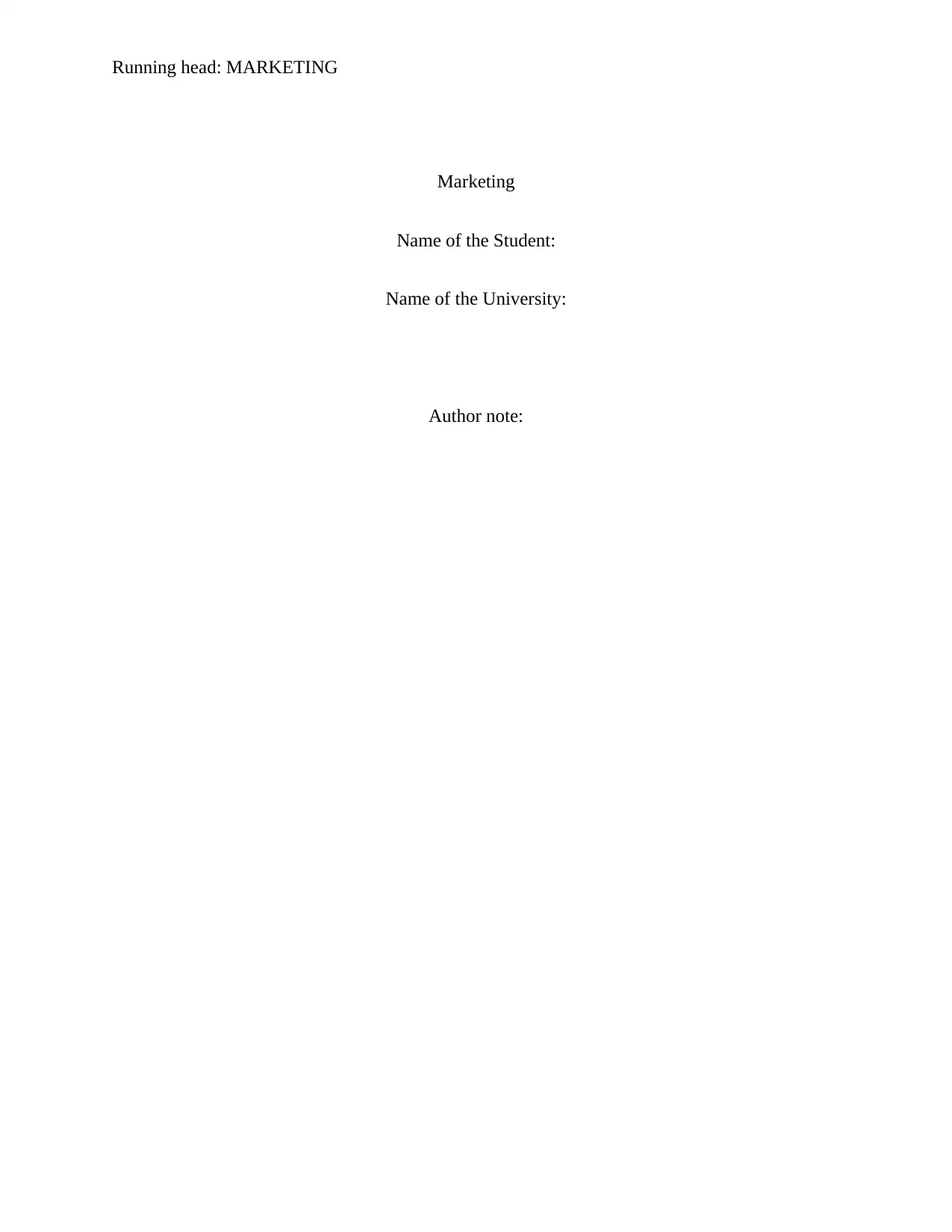
Running head: MARKETING
Marketing
Name of the Student:
Name of the University:
Author note:
Marketing
Name of the Student:
Name of the University:
Author note:
Paraphrase This Document
Need a fresh take? Get an instant paraphrase of this document with our AI Paraphraser
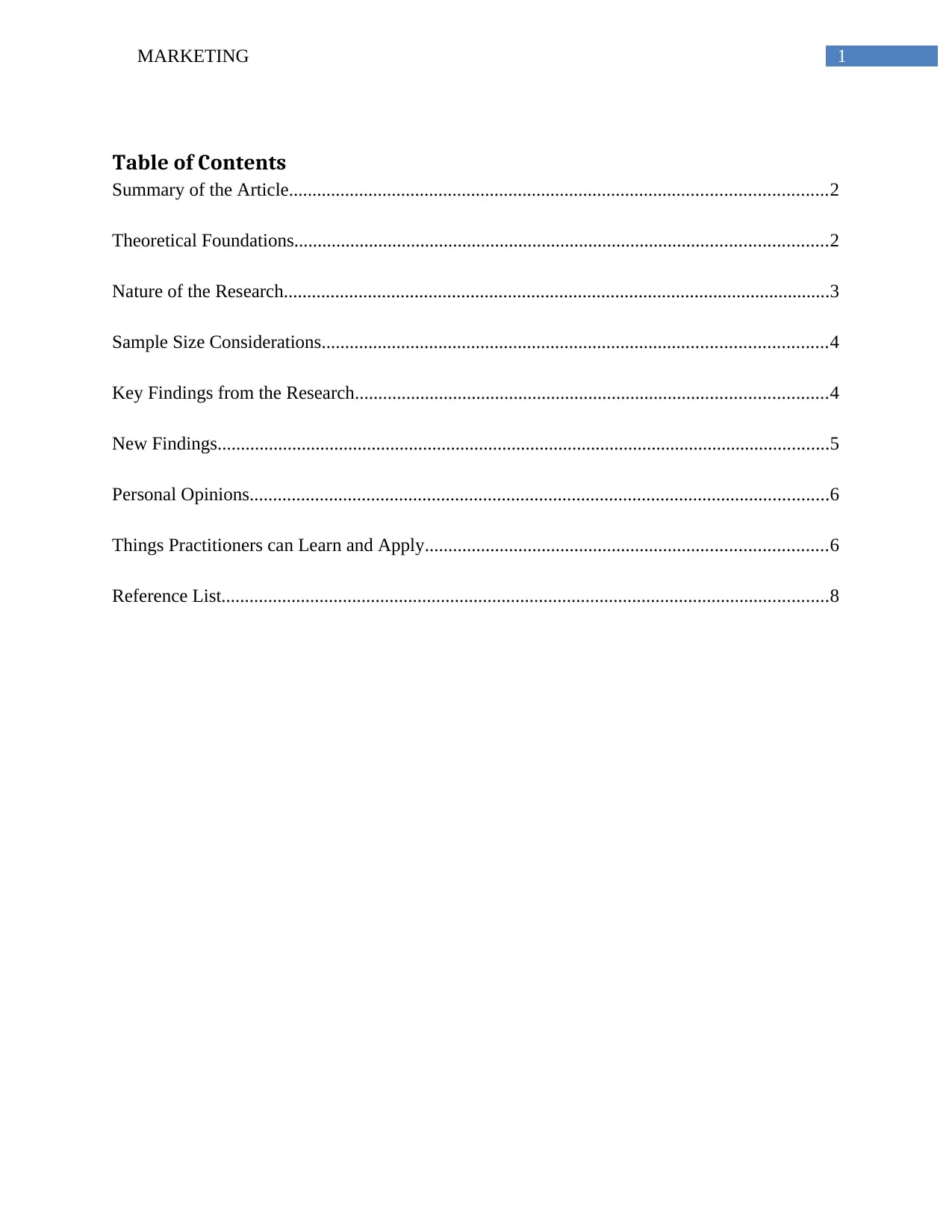
1MARKETING
Table of Contents
Summary of the Article...................................................................................................................2
Theoretical Foundations..................................................................................................................2
Nature of the Research.....................................................................................................................3
Sample Size Considerations............................................................................................................4
Key Findings from the Research.....................................................................................................4
New Findings...................................................................................................................................5
Personal Opinions............................................................................................................................6
Things Practitioners can Learn and Apply......................................................................................6
Reference List..................................................................................................................................8
Table of Contents
Summary of the Article...................................................................................................................2
Theoretical Foundations..................................................................................................................2
Nature of the Research.....................................................................................................................3
Sample Size Considerations............................................................................................................4
Key Findings from the Research.....................................................................................................4
New Findings...................................................................................................................................5
Personal Opinions............................................................................................................................6
Things Practitioners can Learn and Apply......................................................................................6
Reference List..................................................................................................................................8
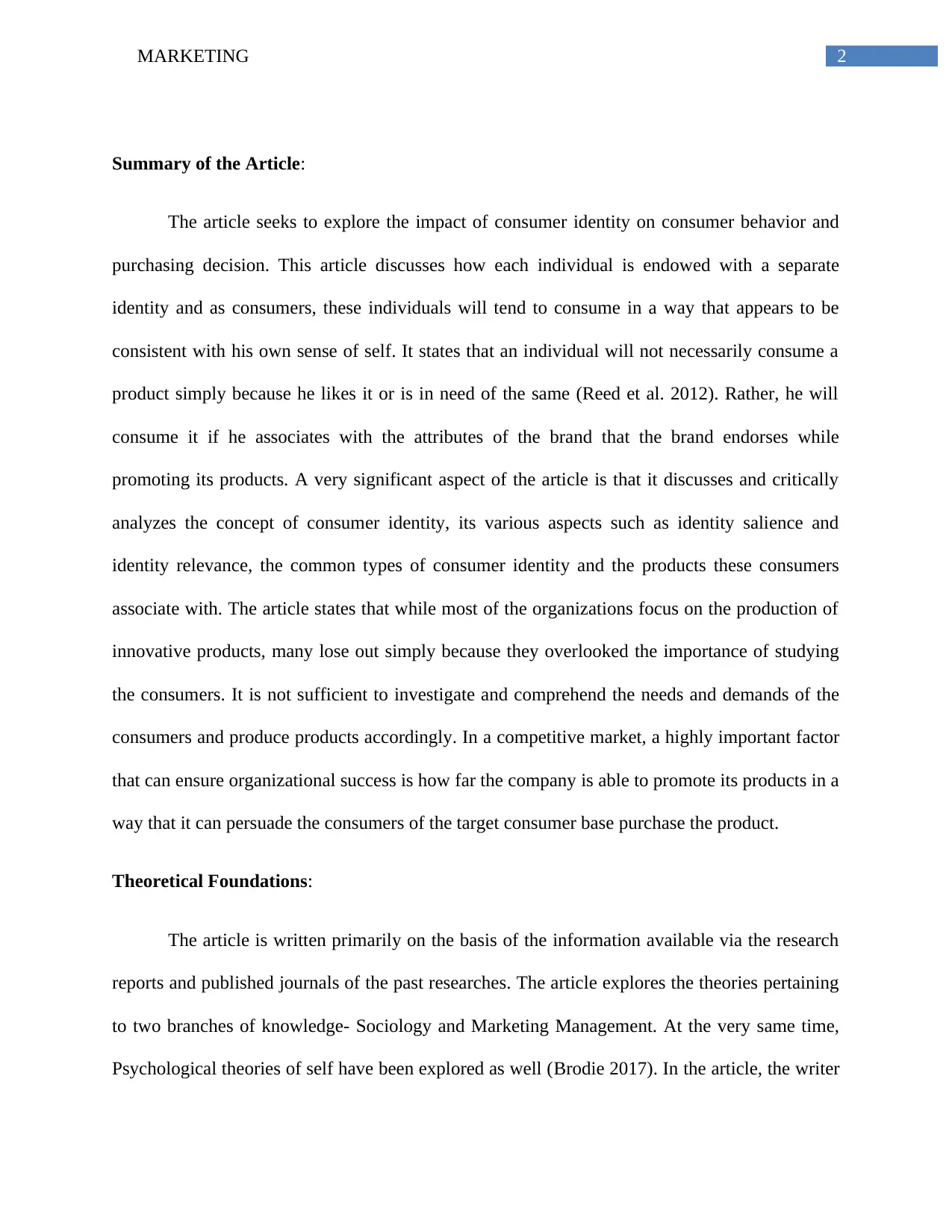
2MARKETING
Summary of the Article:
The article seeks to explore the impact of consumer identity on consumer behavior and
purchasing decision. This article discusses how each individual is endowed with a separate
identity and as consumers, these individuals will tend to consume in a way that appears to be
consistent with his own sense of self. It states that an individual will not necessarily consume a
product simply because he likes it or is in need of the same (Reed et al. 2012). Rather, he will
consume it if he associates with the attributes of the brand that the brand endorses while
promoting its products. A very significant aspect of the article is that it discusses and critically
analyzes the concept of consumer identity, its various aspects such as identity salience and
identity relevance, the common types of consumer identity and the products these consumers
associate with. The article states that while most of the organizations focus on the production of
innovative products, many lose out simply because they overlooked the importance of studying
the consumers. It is not sufficient to investigate and comprehend the needs and demands of the
consumers and produce products accordingly. In a competitive market, a highly important factor
that can ensure organizational success is how far the company is able to promote its products in a
way that it can persuade the consumers of the target consumer base purchase the product.
Theoretical Foundations:
The article is written primarily on the basis of the information available via the research
reports and published journals of the past researches. The article explores the theories pertaining
to two branches of knowledge- Sociology and Marketing Management. At the very same time,
Psychological theories of self have been explored as well (Brodie 2017). In the article, the writer
Summary of the Article:
The article seeks to explore the impact of consumer identity on consumer behavior and
purchasing decision. This article discusses how each individual is endowed with a separate
identity and as consumers, these individuals will tend to consume in a way that appears to be
consistent with his own sense of self. It states that an individual will not necessarily consume a
product simply because he likes it or is in need of the same (Reed et al. 2012). Rather, he will
consume it if he associates with the attributes of the brand that the brand endorses while
promoting its products. A very significant aspect of the article is that it discusses and critically
analyzes the concept of consumer identity, its various aspects such as identity salience and
identity relevance, the common types of consumer identity and the products these consumers
associate with. The article states that while most of the organizations focus on the production of
innovative products, many lose out simply because they overlooked the importance of studying
the consumers. It is not sufficient to investigate and comprehend the needs and demands of the
consumers and produce products accordingly. In a competitive market, a highly important factor
that can ensure organizational success is how far the company is able to promote its products in a
way that it can persuade the consumers of the target consumer base purchase the product.
Theoretical Foundations:
The article is written primarily on the basis of the information available via the research
reports and published journals of the past researches. The article explores the theories pertaining
to two branches of knowledge- Sociology and Marketing Management. At the very same time,
Psychological theories of self have been explored as well (Brodie 2017). In the article, the writer
You're viewing a preview
Unlock full access by subscribing today!
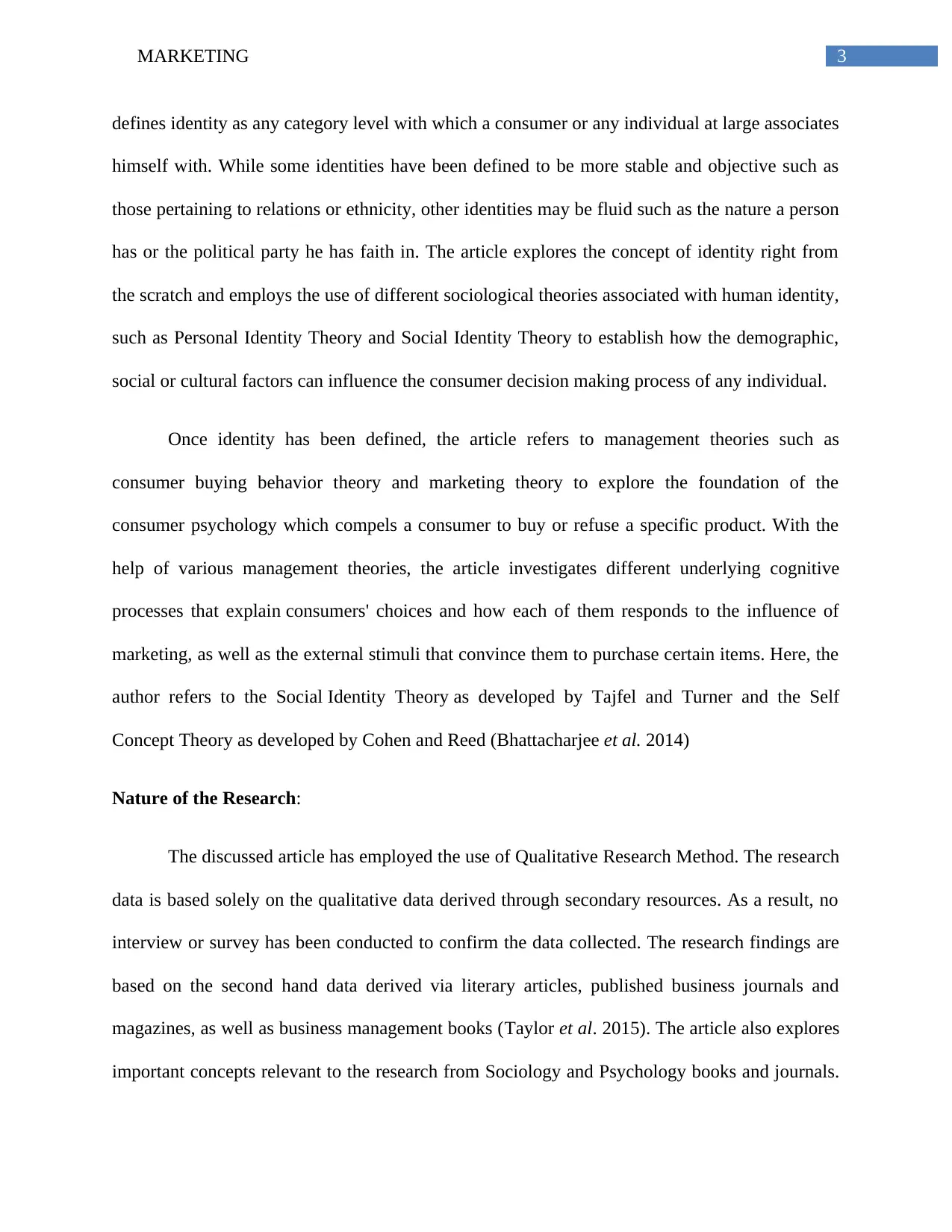
3MARKETING
defines identity as any category level with which a consumer or any individual at large associates
himself with. While some identities have been defined to be more stable and objective such as
those pertaining to relations or ethnicity, other identities may be fluid such as the nature a person
has or the political party he has faith in. The article explores the concept of identity right from
the scratch and employs the use of different sociological theories associated with human identity,
such as Personal Identity Theory and Social Identity Theory to establish how the demographic,
social or cultural factors can influence the consumer decision making process of any individual.
Once identity has been defined, the article refers to management theories such as
consumer buying behavior theory and marketing theory to explore the foundation of the
consumer psychology which compels a consumer to buy or refuse a specific product. With the
help of various management theories, the article investigates different underlying cognitive
processes that explain consumers' choices and how each of them responds to the influence of
marketing, as well as the external stimuli that convince them to purchase certain items. Here, the
author refers to the Social Identity Theory as developed by Tajfel and Turner and the Self
Concept Theory as developed by Cohen and Reed (Bhattacharjee et al. 2014)
Nature of the Research:
The discussed article has employed the use of Qualitative Research Method. The research
data is based solely on the qualitative data derived through secondary resources. As a result, no
interview or survey has been conducted to confirm the data collected. The research findings are
based on the second hand data derived via literary articles, published business journals and
magazines, as well as business management books (Taylor et al. 2015). The article also explores
important concepts relevant to the research from Sociology and Psychology books and journals.
defines identity as any category level with which a consumer or any individual at large associates
himself with. While some identities have been defined to be more stable and objective such as
those pertaining to relations or ethnicity, other identities may be fluid such as the nature a person
has or the political party he has faith in. The article explores the concept of identity right from
the scratch and employs the use of different sociological theories associated with human identity,
such as Personal Identity Theory and Social Identity Theory to establish how the demographic,
social or cultural factors can influence the consumer decision making process of any individual.
Once identity has been defined, the article refers to management theories such as
consumer buying behavior theory and marketing theory to explore the foundation of the
consumer psychology which compels a consumer to buy or refuse a specific product. With the
help of various management theories, the article investigates different underlying cognitive
processes that explain consumers' choices and how each of them responds to the influence of
marketing, as well as the external stimuli that convince them to purchase certain items. Here, the
author refers to the Social Identity Theory as developed by Tajfel and Turner and the Self
Concept Theory as developed by Cohen and Reed (Bhattacharjee et al. 2014)
Nature of the Research:
The discussed article has employed the use of Qualitative Research Method. The research
data is based solely on the qualitative data derived through secondary resources. As a result, no
interview or survey has been conducted to confirm the data collected. The research findings are
based on the second hand data derived via literary articles, published business journals and
magazines, as well as business management books (Taylor et al. 2015). The article also explores
important concepts relevant to the research from Sociology and Psychology books and journals.
Paraphrase This Document
Need a fresh take? Get an instant paraphrase of this document with our AI Paraphraser
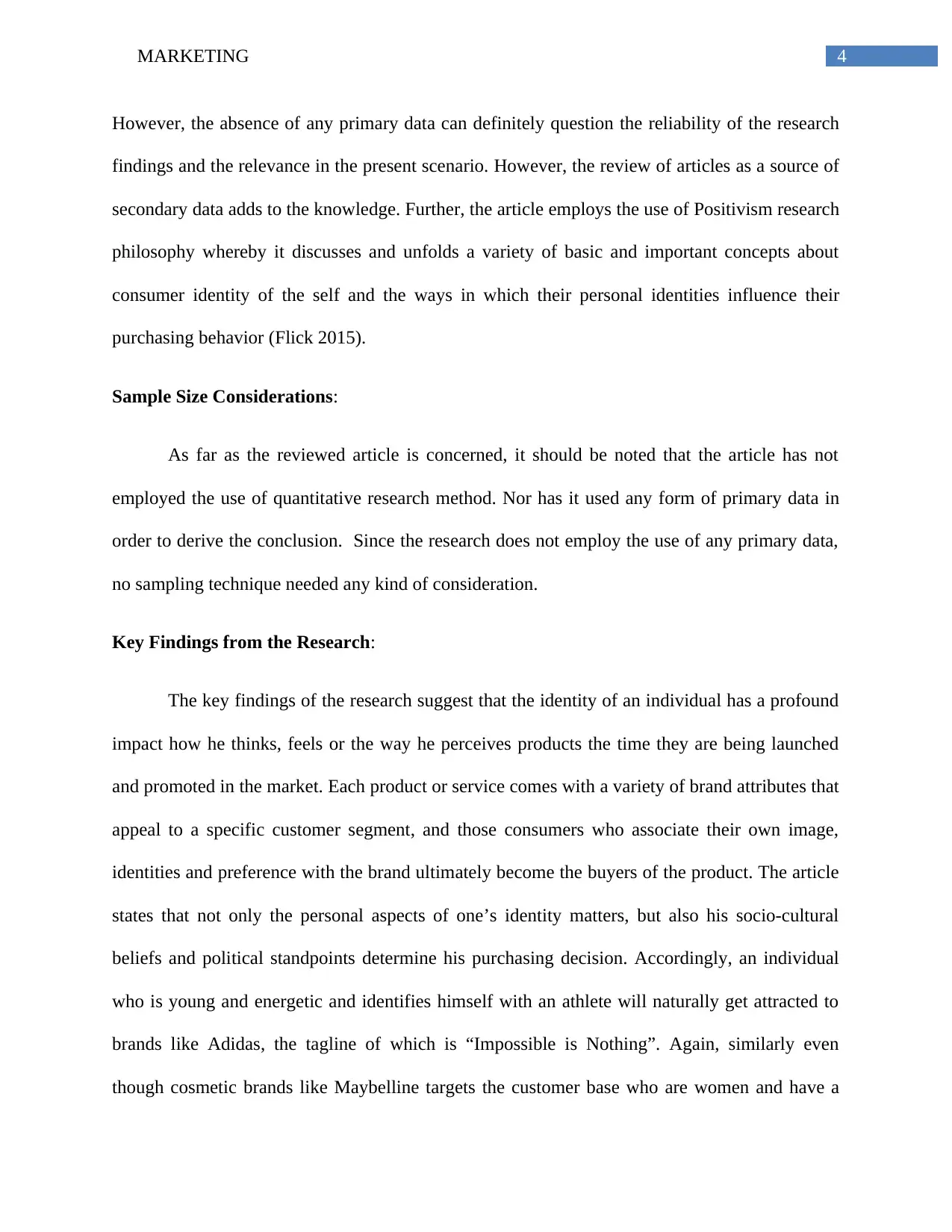
4MARKETING
However, the absence of any primary data can definitely question the reliability of the research
findings and the relevance in the present scenario. However, the review of articles as a source of
secondary data adds to the knowledge. Further, the article employs the use of Positivism research
philosophy whereby it discusses and unfolds a variety of basic and important concepts about
consumer identity of the self and the ways in which their personal identities influence their
purchasing behavior (Flick 2015).
Sample Size Considerations:
As far as the reviewed article is concerned, it should be noted that the article has not
employed the use of quantitative research method. Nor has it used any form of primary data in
order to derive the conclusion. Since the research does not employ the use of any primary data,
no sampling technique needed any kind of consideration.
Key Findings from the Research:
The key findings of the research suggest that the identity of an individual has a profound
impact how he thinks, feels or the way he perceives products the time they are being launched
and promoted in the market. Each product or service comes with a variety of brand attributes that
appeal to a specific customer segment, and those consumers who associate their own image,
identities and preference with the brand ultimately become the buyers of the product. The article
states that not only the personal aspects of one’s identity matters, but also his socio-cultural
beliefs and political standpoints determine his purchasing decision. Accordingly, an individual
who is young and energetic and identifies himself with an athlete will naturally get attracted to
brands like Adidas, the tagline of which is “Impossible is Nothing”. Again, similarly even
though cosmetic brands like Maybelline targets the customer base who are women and have a
However, the absence of any primary data can definitely question the reliability of the research
findings and the relevance in the present scenario. However, the review of articles as a source of
secondary data adds to the knowledge. Further, the article employs the use of Positivism research
philosophy whereby it discusses and unfolds a variety of basic and important concepts about
consumer identity of the self and the ways in which their personal identities influence their
purchasing behavior (Flick 2015).
Sample Size Considerations:
As far as the reviewed article is concerned, it should be noted that the article has not
employed the use of quantitative research method. Nor has it used any form of primary data in
order to derive the conclusion. Since the research does not employ the use of any primary data,
no sampling technique needed any kind of consideration.
Key Findings from the Research:
The key findings of the research suggest that the identity of an individual has a profound
impact how he thinks, feels or the way he perceives products the time they are being launched
and promoted in the market. Each product or service comes with a variety of brand attributes that
appeal to a specific customer segment, and those consumers who associate their own image,
identities and preference with the brand ultimately become the buyers of the product. The article
states that not only the personal aspects of one’s identity matters, but also his socio-cultural
beliefs and political standpoints determine his purchasing decision. Accordingly, an individual
who is young and energetic and identifies himself with an athlete will naturally get attracted to
brands like Adidas, the tagline of which is “Impossible is Nothing”. Again, similarly even
though cosmetic brands like Maybelline targets the customer base who are women and have a
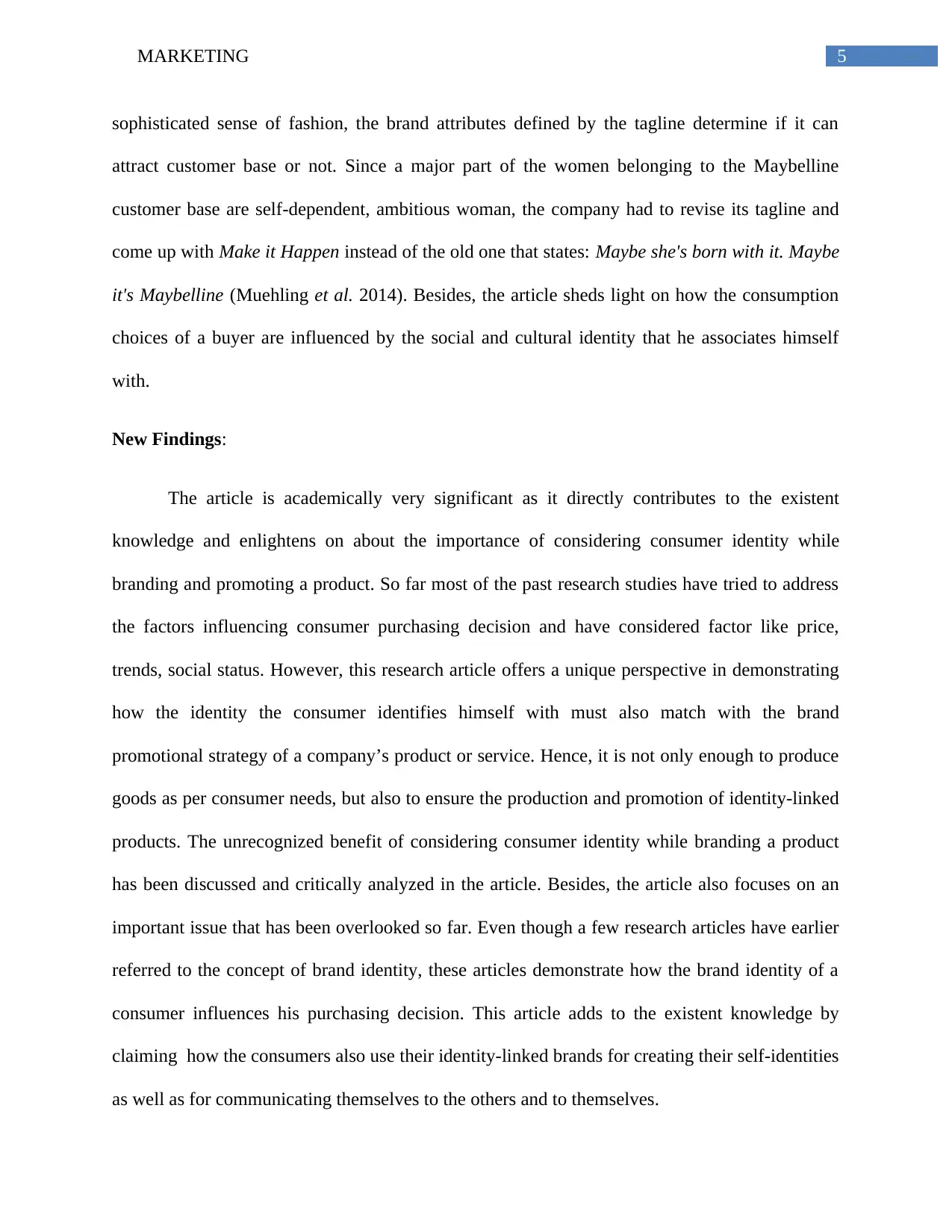
5MARKETING
sophisticated sense of fashion, the brand attributes defined by the tagline determine if it can
attract customer base or not. Since a major part of the women belonging to the Maybelline
customer base are self-dependent, ambitious woman, the company had to revise its tagline and
come up with Make it Happen instead of the old one that states: Maybe she's born with it. Maybe
it's Maybelline (Muehling et al. 2014). Besides, the article sheds light on how the consumption
choices of a buyer are influenced by the social and cultural identity that he associates himself
with.
New Findings:
The article is academically very significant as it directly contributes to the existent
knowledge and enlightens on about the importance of considering consumer identity while
branding and promoting a product. So far most of the past research studies have tried to address
the factors influencing consumer purchasing decision and have considered factor like price,
trends, social status. However, this research article offers a unique perspective in demonstrating
how the identity the consumer identifies himself with must also match with the brand
promotional strategy of a company’s product or service. Hence, it is not only enough to produce
goods as per consumer needs, but also to ensure the production and promotion of identity-linked
products. The unrecognized benefit of considering consumer identity while branding a product
has been discussed and critically analyzed in the article. Besides, the article also focuses on an
important issue that has been overlooked so far. Even though a few research articles have earlier
referred to the concept of brand identity, these articles demonstrate how the brand identity of a
consumer influences his purchasing decision. This article adds to the existent knowledge by
claiming how the consumers also use their identity-linked brands for creating their self-identities
as well as for communicating themselves to the others and to themselves.
sophisticated sense of fashion, the brand attributes defined by the tagline determine if it can
attract customer base or not. Since a major part of the women belonging to the Maybelline
customer base are self-dependent, ambitious woman, the company had to revise its tagline and
come up with Make it Happen instead of the old one that states: Maybe she's born with it. Maybe
it's Maybelline (Muehling et al. 2014). Besides, the article sheds light on how the consumption
choices of a buyer are influenced by the social and cultural identity that he associates himself
with.
New Findings:
The article is academically very significant as it directly contributes to the existent
knowledge and enlightens on about the importance of considering consumer identity while
branding and promoting a product. So far most of the past research studies have tried to address
the factors influencing consumer purchasing decision and have considered factor like price,
trends, social status. However, this research article offers a unique perspective in demonstrating
how the identity the consumer identifies himself with must also match with the brand
promotional strategy of a company’s product or service. Hence, it is not only enough to produce
goods as per consumer needs, but also to ensure the production and promotion of identity-linked
products. The unrecognized benefit of considering consumer identity while branding a product
has been discussed and critically analyzed in the article. Besides, the article also focuses on an
important issue that has been overlooked so far. Even though a few research articles have earlier
referred to the concept of brand identity, these articles demonstrate how the brand identity of a
consumer influences his purchasing decision. This article adds to the existent knowledge by
claiming how the consumers also use their identity-linked brands for creating their self-identities
as well as for communicating themselves to the others and to themselves.
You're viewing a preview
Unlock full access by subscribing today!
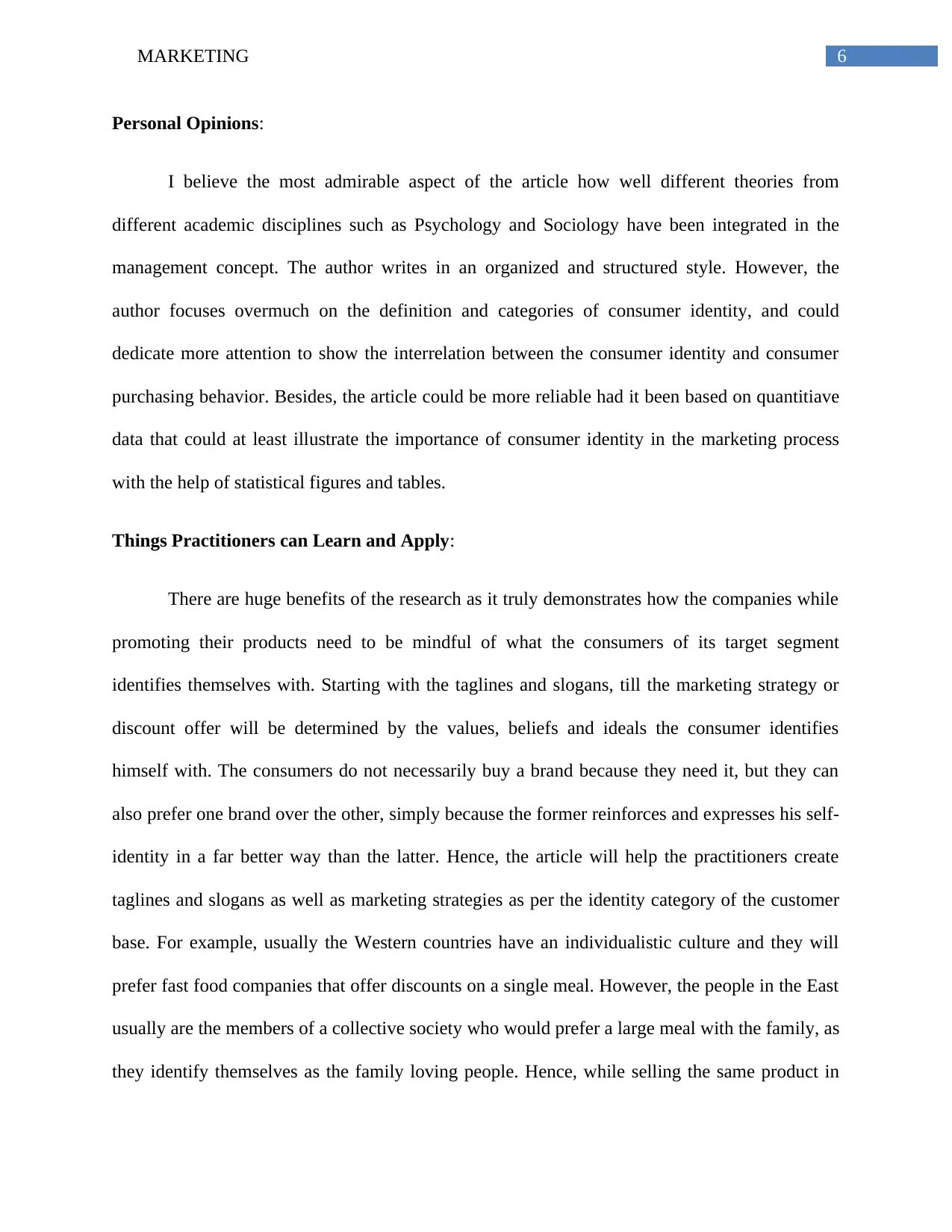
6MARKETING
Personal Opinions:
I believe the most admirable aspect of the article how well different theories from
different academic disciplines such as Psychology and Sociology have been integrated in the
management concept. The author writes in an organized and structured style. However, the
author focuses overmuch on the definition and categories of consumer identity, and could
dedicate more attention to show the interrelation between the consumer identity and consumer
purchasing behavior. Besides, the article could be more reliable had it been based on quantitiave
data that could at least illustrate the importance of consumer identity in the marketing process
with the help of statistical figures and tables.
Things Practitioners can Learn and Apply:
There are huge benefits of the research as it truly demonstrates how the companies while
promoting their products need to be mindful of what the consumers of its target segment
identifies themselves with. Starting with the taglines and slogans, till the marketing strategy or
discount offer will be determined by the values, beliefs and ideals the consumer identifies
himself with. The consumers do not necessarily buy a brand because they need it, but they can
also prefer one brand over the other, simply because the former reinforces and expresses his self-
identity in a far better way than the latter. Hence, the article will help the practitioners create
taglines and slogans as well as marketing strategies as per the identity category of the customer
base. For example, usually the Western countries have an individualistic culture and they will
prefer fast food companies that offer discounts on a single meal. However, the people in the East
usually are the members of a collective society who would prefer a large meal with the family, as
they identify themselves as the family loving people. Hence, while selling the same product in
Personal Opinions:
I believe the most admirable aspect of the article how well different theories from
different academic disciplines such as Psychology and Sociology have been integrated in the
management concept. The author writes in an organized and structured style. However, the
author focuses overmuch on the definition and categories of consumer identity, and could
dedicate more attention to show the interrelation between the consumer identity and consumer
purchasing behavior. Besides, the article could be more reliable had it been based on quantitiave
data that could at least illustrate the importance of consumer identity in the marketing process
with the help of statistical figures and tables.
Things Practitioners can Learn and Apply:
There are huge benefits of the research as it truly demonstrates how the companies while
promoting their products need to be mindful of what the consumers of its target segment
identifies themselves with. Starting with the taglines and slogans, till the marketing strategy or
discount offer will be determined by the values, beliefs and ideals the consumer identifies
himself with. The consumers do not necessarily buy a brand because they need it, but they can
also prefer one brand over the other, simply because the former reinforces and expresses his self-
identity in a far better way than the latter. Hence, the article will help the practitioners create
taglines and slogans as well as marketing strategies as per the identity category of the customer
base. For example, usually the Western countries have an individualistic culture and they will
prefer fast food companies that offer discounts on a single meal. However, the people in the East
usually are the members of a collective society who would prefer a large meal with the family, as
they identify themselves as the family loving people. Hence, while selling the same product in
Paraphrase This Document
Need a fresh take? Get an instant paraphrase of this document with our AI Paraphraser

7MARKETING
the market of an Eastern country, the company should offer heavy discounts on the large meals.
Hence, it is highly important for the business managers to consider the idea of producing
identity-linked products.
the market of an Eastern country, the company should offer heavy discounts on the large meals.
Hence, it is highly important for the business managers to consider the idea of producing
identity-linked products.
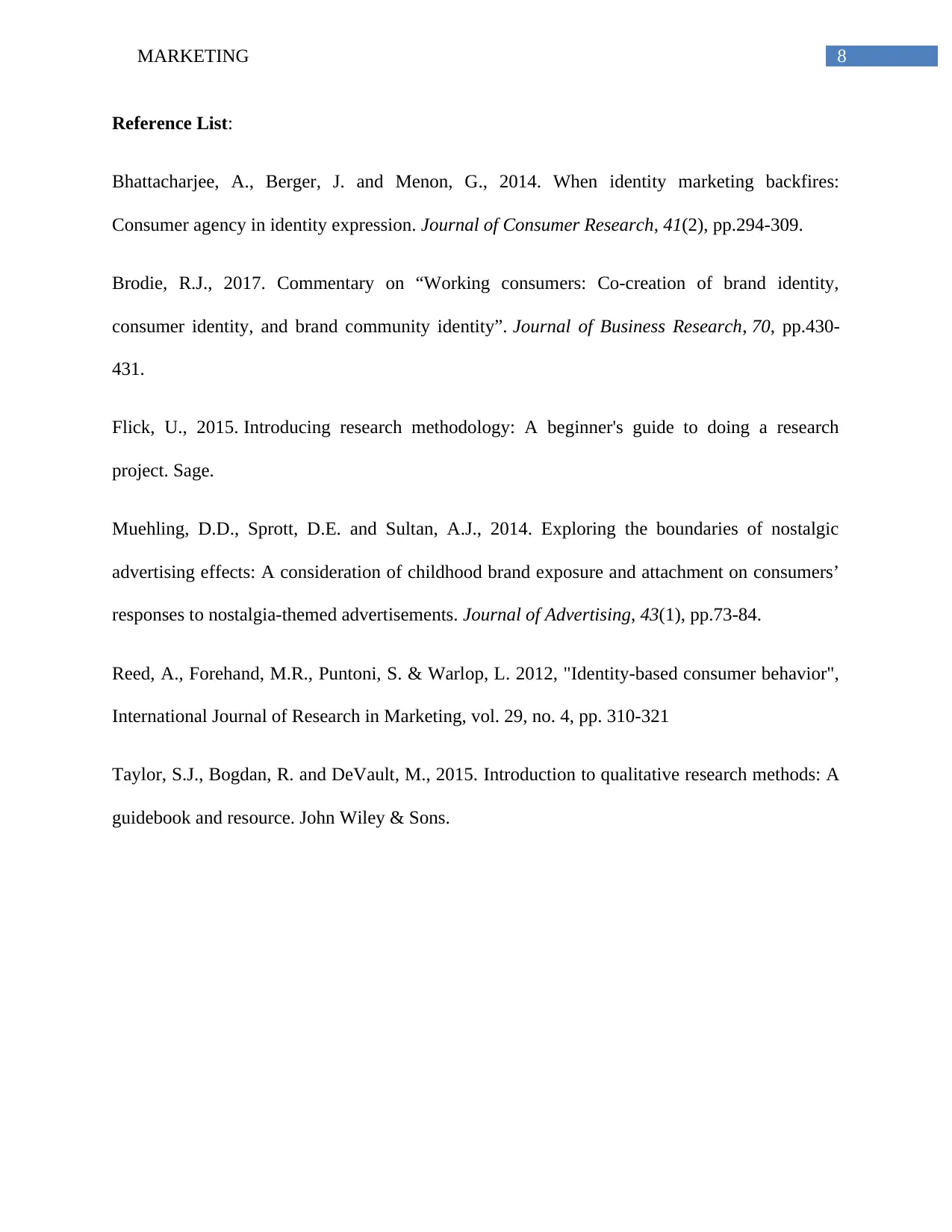
8MARKETING
Reference List:
Bhattacharjee, A., Berger, J. and Menon, G., 2014. When identity marketing backfires:
Consumer agency in identity expression. Journal of Consumer Research, 41(2), pp.294-309.
Brodie, R.J., 2017. Commentary on “Working consumers: Co-creation of brand identity,
consumer identity, and brand community identity”. Journal of Business Research, 70, pp.430-
431.
Flick, U., 2015. Introducing research methodology: A beginner's guide to doing a research
project. Sage.
Muehling, D.D., Sprott, D.E. and Sultan, A.J., 2014. Exploring the boundaries of nostalgic
advertising effects: A consideration of childhood brand exposure and attachment on consumers’
responses to nostalgia-themed advertisements. Journal of Advertising, 43(1), pp.73-84.
Reed, A., Forehand, M.R., Puntoni, S. & Warlop, L. 2012, "Identity-based consumer behavior",
International Journal of Research in Marketing, vol. 29, no. 4, pp. 310-321
Taylor, S.J., Bogdan, R. and DeVault, M., 2015. Introduction to qualitative research methods: A
guidebook and resource. John Wiley & Sons.
Reference List:
Bhattacharjee, A., Berger, J. and Menon, G., 2014. When identity marketing backfires:
Consumer agency in identity expression. Journal of Consumer Research, 41(2), pp.294-309.
Brodie, R.J., 2017. Commentary on “Working consumers: Co-creation of brand identity,
consumer identity, and brand community identity”. Journal of Business Research, 70, pp.430-
431.
Flick, U., 2015. Introducing research methodology: A beginner's guide to doing a research
project. Sage.
Muehling, D.D., Sprott, D.E. and Sultan, A.J., 2014. Exploring the boundaries of nostalgic
advertising effects: A consideration of childhood brand exposure and attachment on consumers’
responses to nostalgia-themed advertisements. Journal of Advertising, 43(1), pp.73-84.
Reed, A., Forehand, M.R., Puntoni, S. & Warlop, L. 2012, "Identity-based consumer behavior",
International Journal of Research in Marketing, vol. 29, no. 4, pp. 310-321
Taylor, S.J., Bogdan, R. and DeVault, M., 2015. Introduction to qualitative research methods: A
guidebook and resource. John Wiley & Sons.
You're viewing a preview
Unlock full access by subscribing today!
1 out of 9
Related Documents
Your All-in-One AI-Powered Toolkit for Academic Success.
+13062052269
info@desklib.com
Available 24*7 on WhatsApp / Email
![[object Object]](/_next/static/media/star-bottom.7253800d.svg)
Unlock your academic potential
© 2024 | Zucol Services PVT LTD | All rights reserved.





